The Legends of Shakti
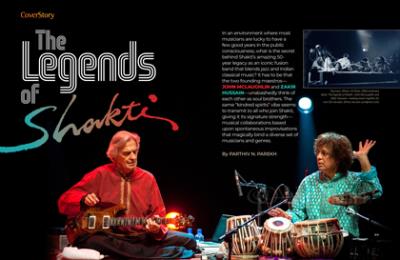
[Left] The legends of Shakti—John McLaughlin and Zakir Hussain—making music together for over five decades. (Photo Aworan.wordpress.com)
In an environment where most musicians are lucky to have a few good years in the public consciousness, what is the secret behind Shakti’s amazing 50- year legacy as an iconic fusion band that blends jazz and Indian classical music? It has to be that the two founding maestros— JOHN MCLAUGHLIN and ZAKIR HUSSAIN—unabashedly think of each other as soul brothers. The same “kindred spirits” vibe seems to transmit to all who join Shakti, giving it its signature strength— musical collaborations based upon spontaneous improvisations that magically bind a diverse set of musicians and genres.
Shakti has served as a fluid forum where some of the best-known legends of jazz and Indian classical music have come together for a period of time to leave their footprint in the annals of world music, soon making space for other talented exponents of these genres.
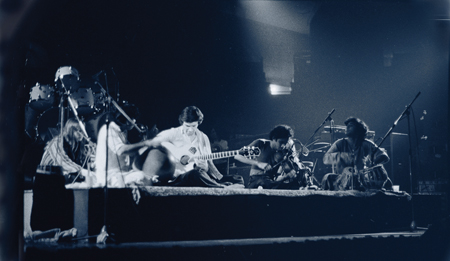
Whether they were world renowned or were obscure folk musicians hand-picked by Hussain and McLaughlin from the rural hinterlands, the one thing common between all who shared the Shakti space was their impassioned dedication to their art form, the result of which was music which sparked awe as well as unbridled joy.
(Photo: Ali Khan, WikiCommons)
Improvisation, playfulness, and even mischief when indulged in by amateur artists, could perhaps make for some passing fun; but in the hands of seasoned virtuosos, these very same elements transform the experience for both the musicians and the listeners to a sublime joy, and even an ethereal experience in those moments when such performances hit the peak.
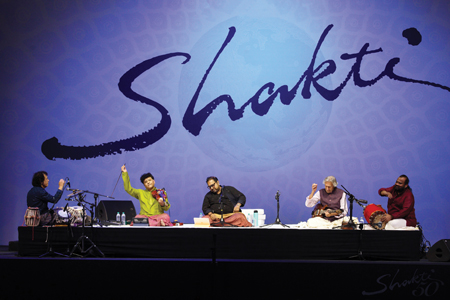
The 50th anniversary concert tour features Zakir Hussain (Tabla, Chanda, Madal, Konokol); Ganesh Rajagopalan (Violin, Konokol); Shankar Mahadevan (Vocals, Konokol); John McLaughlin (Guitar, Acoustic Guitar, Guitar Synth); and V. Selvaganesh (Kanjira, Mridangam, Ghatam, Konokol).
It is this element of almost spiritual exuberance, expressed in music, that sets Shakti apart as an ensemble that has gifted a 50-year treasure trove of memorable performances. Particularly worth mentioning are many of those immensely enjoyable juggalbandis, which were all the more fascinating when they spontaneously materialized as a result of instinctual synergy between diverse musicians and their equally disparate genres. It is as if the differences melted away, making way for a universal language of music.
Speaking of such experiences, McLaughlin says, “The entire group becomes so inspired that we become almost one being. I don’t know how else to express it. We are so unified. And it’s one of the most joyful experiences I’ve ever had in my life. And it still comes today, after all these years.”
Much has changed in the world since a young John and Zakir joined hands in the ’70s in what could be described as an experiment in defying Rudyard Kipling—they set out to make music from the East not only meet the music from the West, but also for them to mingle and marry, for a happily ever after.
Amidst all the ebb and flow of the many talented artists who have come and gone through this ensemble, it is only McLaughlin and Hussain who, besides being the founders, have remained the consistent pillars of the band. There is a bond between them that far surpasses the music for which they have come together. They endearingly refer to each other as “bhai.”
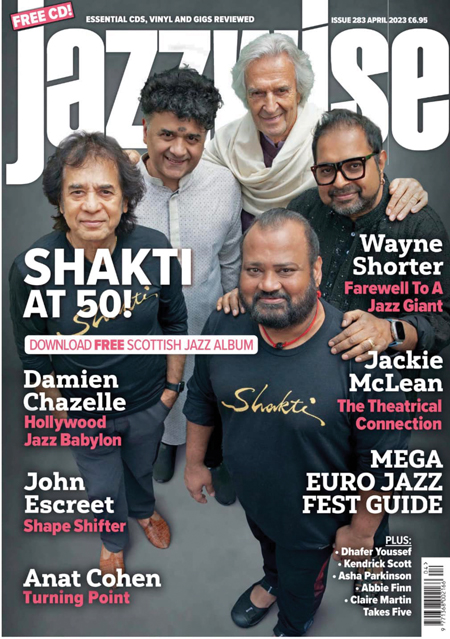
Recalling their very first impromptu jam session in 1972, when both were invited to dinner at the home of Ustaad Ali Akbar Khan, the sarod maestro, McLaughlin is quoted in The Telegraph as saying, “So, we sat down and played. And in a space of five minutes, it was one of the greatest experiences for me. Things happened later with L. Shankar and the other members of the band. But that meeting was, in my heart, the principal foundation in the formation of Shakti.”
Hussain too, as per an article in relix.com, reports similar feelings about that first jam session they ever had: “When I first played with John McLaughlin . . . it was like we had been playing together for decades. We thought of the same rhythmic melodic patterns. We even started and stopped at the same time. We looked at each other and broke out in giggles because how was that even possible?”
“It happens very rarely in life where you meet a musician, and from the very first moment, you are meant to play together. There’s nothing you can do about it—it’s written in the stars. What can I say?” reflects McLaughlin.
[Left] Shakti has been well recognized in world press as the iconic fusion band with an impressive footprint in world music.
The Backstory
Fifty years back, convinced by the deep artistic and spiritual bonding with Zakir Hussain, British guitarist John McLaughlin, to the disbelief of his minders and managers, made the visionary decision to disband the Mahavishnu Orchestra, his already well-established fusion band, in favor of pouring his heart and soul in conceiving and launching Shakti, the band that would become iconic in the genre of Indo-jazz fusion.
Hussain doesn’t hold back from acknowledging McLaughlin’s outsized impact on the creation and sustenance of Shakti: “It has always been Johnbhai’s energy that has driven Shakti. He was the one who thought that this should happen. And the very first tour or two, he even financed it himself.” And adds: “Every time that we have reemerged after a hiatus, it has always been Johnji who has taken the initiative.”
And the feeling is mutual. McLaughlin says, “I would go as far as to say that because of Zakir, Shakti continues to exist. The tie between Zakir and myself is so strong. He is like my brother to me. I cannot see him as anything other than my family. I cannot emphasize strongly enough the impact that he made on myself, and that I made on him.”
Despite his deep conviction towards their new venture, at the time, perhaps even McLaughlin could not have imagined the extent of impact in world music that Shakti would manage to make in its five decades. The band has enthralled legions of fans of varied genres from around the world with their inimitable synergy and inspired improvisations.
The Interviews
Our wide-ranging interviews with both McLaughlin and Hussain, appearing in the following pages, provide not only a peek into the sense and sensibilities that make both of them tick but also seasoned insights on classical music, their instruments—guitar and tabla, respectively—and how they have influenced each other, and more.
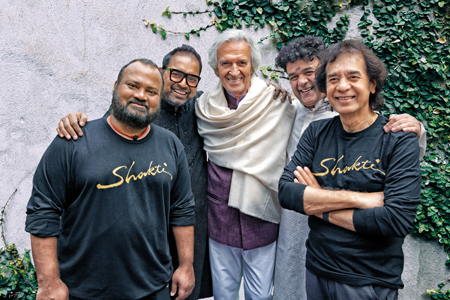
These seasoned maestros will be performing in Atlanta on August 25, 2023.
A Polyglot Guitarist's Indian Adventures
With close to six decades of his passionate love affair with the guitar, JOHN McLAUGHLIN has made an indelible impression in the world of jazz, rock, Western classical music, flamenco, blues, and Indo-jazz fusion. His love affair with the latter began as a young man who went to India on a spiritual quest. Not surprisingly, Shakti, the iconic band he co-started with tabla maestro Zakir Hussain, is celebrating its 50th year anniversary—a feat that is possible only because of the soul connections between its members.
By NIKHIL MISRA-BHAMBRI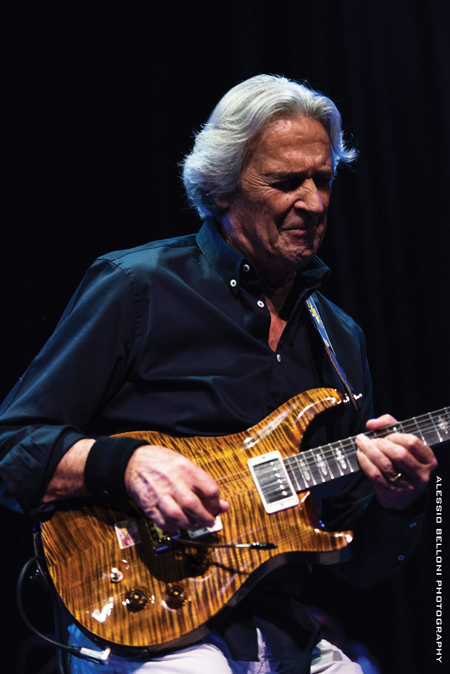
According to Rolling Stone magazine, John McLaughlin “. . . achieved guitar-god status with his own Mahavishnu Orchestra, where he made his Gibson spit fire like a many-headed dragon.”
The article, which recognizes the 100 Greatest Guitarists, goes on to say, “A breakneck stylist, McLaughlin was peerless, mixing psychedelic rock, R&B, gypsy jazz, flamenco and Indian raga techniques.” That polyglot mastery earned him huge respect from jazz and rock peers alike: Jeff Beck called him “the best guitarist alive.”
Jazz Blues News credits McLaughlin as “perhaps the first western musician to fully integrate the complex rhythms and melodic improvisations of the Indian classical traditions into his own playing, which reached its virtuosic zenith in his Indian supergroup Shakti.”
It is McLaughlin’s contemporary cosmopolitan persona as a citizen of the world who is passionately open to all cultures, along with his adventurous spirit of bringing that into his music, which has made him a musician of global renown.
McLaughlin, as we found out, is a particularly gracious interviewee. Following are excerpts from our endearing conversation with him over a video call.
(Photo: Alessio Belloni)
How did your interest in India begin? What experiences in India made an impact?
Big question! Being an old hippie, I was part of that movement in the mid-’60s where we were all dropping acid. It was a very liberating decade, musically, psychologically, emotionally. It was a time when I was asking the big questions about existence: What’s God? What am I doing here? What is this fabulous, mysterious universe? And what’s my role in it? What’s the role of music in life?
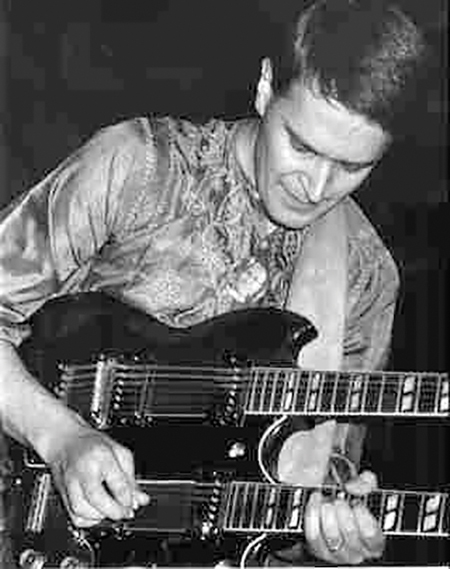 Like the Beatles, Rolling Stones, and many other Western musicians, I too turned to India to seek answers to these existential questions, which India has been doing for about 5000 years now. In about 1967, when I started doing yoga and meditation, I discovered that Indian music was very much part of this culture.
Like the Beatles, Rolling Stones, and many other Western musicians, I too turned to India to seek answers to these existential questions, which India has been doing for about 5000 years now. In about 1967, when I started doing yoga and meditation, I discovered that Indian music was very much part of this culture.
I heard the amazing musicians, the improvisations, and the rhythm, and realized that jazz and Indian music have a great deal in common. It became necessary for me to study Indian music. I wanted to understand the ragas and the talas. And so, I began studying seriously. I started off with the Indian flute, and by 1972 I was studying the South Indian veena under Dr. Ramanathan.
It is because of the impact of Indian music, coupled with the realization that meditation and yoga were so beneficial to me, that I have an undying gratitude for India. The very first time I went to India in 1975, I was so enchanted by it that when I came out of the Mumbai airport, I wanted to kiss the ground. I still have this great, profound affection for India and its culture.
[Left] A young McLaughlin performing in Munich, West Germany, in 1973. (Photo: Sdurabito, Wikicommons)
How have Indian spiritual influences impacted your musical approach?
I’ve studied North Indian and South Indian music, and even had the great honor of being accepted by Pandit Ravi Shankar in the 1970s as his student. Yet, at heart, I’m a Western musician. As Western musicians, we have different considerations, because we have to understand and articulate harmony, which is not innate to Indian classical, which emphasizes ragas and rhythms. This is one of the critical aspects of my role in Shakti—to be able to bring in harmony without compromising the ragas. Shankar Mahadevan and Ganesh Rajagopalan are champions of classical ragas. My job is to bend the rules of harmony that will allow them the ragas. I love that.
What is different about Shakti’s approach compared to other intercultural bands you have been a part of, such as the Mahavishnu Orchestra?
Well, the Mahavishnu Orchestra came when I became a disciple of my meditation guru in 1970. I spent five years with him, and it was a marvelous experience that really changed my life. He gave me the spiritual name Mahavishnu.
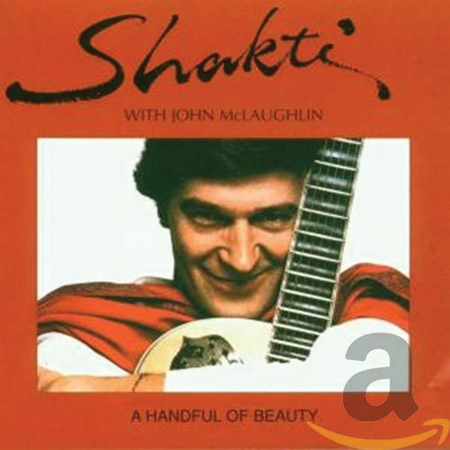
I formed the band with Miles Davis and Tony Williams. We were loud and very strong, and so the name—the Mahavishnu Orchestra. This was one of the first jazz- rock fusion bands. But because I had been studying Indian music, I had been able to bring the complex rhythms into the harmonies.
Shakti was radically different. First of all, when we first started, it was purely acoustic. And we were playing just ragas. There was L. Shanker (violin), Zakir Hussain (tabla), T.H. Vinayakram (ghatam), and I on the guitar.
[Right] John McLaughlin’s first Shakti album, released in 1976.
Since improvisation has always been at the heart of jazz as well as Indian music, once we had a piece—bhajan, kriti, or a new composition—we would soon move to the improvisation. This is where we all become spontaneous, and we become ourselves. It was very natural for me to be able to improvise with percussion players like Zakir Hussain and T. H. Vinayakram. It was just marvelous. Even after 50 years, I’m thrilled about it. This, I think, is a real accomplishment.
Would you say Western classical music and Indian classical music speak to different aspects of our being? What appeals to you the most about both these genres?
In both these cultures, you have melody and rhythm and arrangements. The one difference with Western classical music is its harmony. In Western music, we have to understand (and, in a way, de-structure) harmony to be able to improvise. I’m helping some Indian musicians on how to improvise in Western harmony, because more and more, they want to be able to function with Western musicians. And, of course, it’s difficult because their traditions of ragas are linear. Bollywood, in a sense, is trying to incorporate simple harmony into its music. Eventually it will become more sophisticated.
So how are you able to blend the ragas with improvisation?
Ragas are another name for scale. In Western music, we have many scales; you can consider them as ragas. Because the music is more secular in the West, we don’t have that precision of whether this is an evening scale or a night scale or day scale. But we have so many different scales in Western classical music, and many of them are quite identical to Indian ragas.
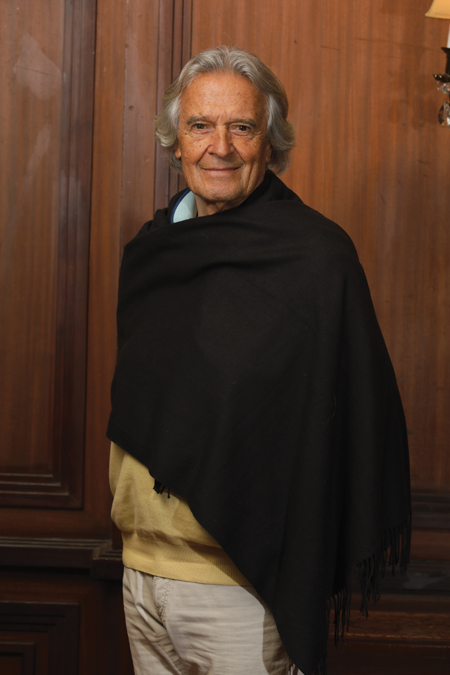 Now that you’ve become very familiar with both Western and Indian music, what are some elements of Western music that Indian music should adopt and vice versa?
Now that you’ve become very familiar with both Western and Indian music, what are some elements of Western music that Indian music should adopt and vice versa?
I would like to see jazz musicians study Indian music. The great John Coltrane, who was one of my heroes, was a very dear friend of Panditji, who helped him understand Indian music. He certainly helped me when he spoke to me over those periods in the 1970s. This is what I would like to see—Western musicians, whether classical or jazz, study more profoundly, not just superficially, the way the Indian musicians play and improvise. While I already have two or three Indian students who I’m teaching harmony to, I would like to see more of this happening.
[Left] McLaughlin, who has studied Hindustani and Carnatic music, has been a leading pioneer in bridging the gap between Western and Indian classical music.
Over the years, what have you learned about Indian classical music that may have surprised or impressed you?
I don’t stop learning about Indian classical music. I listen to the people who inspire me, whether they are North Indian or South Indian. For example, I’m a great fan of Qawalli, which is not specifically Indian classical music, but it’s marvelous music. And it’s essentially a devotional kind of music, isn’t it? But there’s such a rhythm and joy in the singing.
The Alchemist of Tabla
From time immemorial, the tabla and its predecessors such as the pakhawaj have enjoyed an important place in the repertoire of Indian classical music. But it took a prodigy like Ustad ZAKIR HUSSAIN, and his decades of dedication to the instrument, to put it on the world map. For example, the tabla now frequently features in the soundtracks of Hollywood movies. In our exclusive interview with the impassioned virtuoso, it becomes quite evident that it is because of his firm roots in the Indian musical tradition where sound is worshiped as God (Naad Brahma) that, in his hands, the tabla casts magical spells.
By SHUCHITA RAO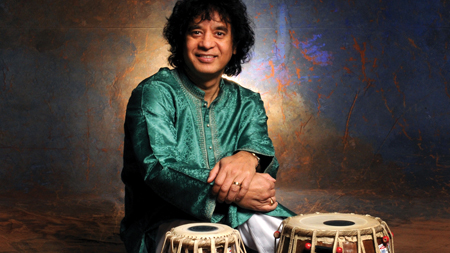
Abundant natural talent backed by years of riyaaz (rigorous music practice) under the watchful eyes of his father, the late Ustad Allarakha Qureshi, carved the way for Zakir Hussain’s impressive musical journey. Along the way, Hussain has not only become a celebrated maestro of tabla, but also a leading icon of Indian classical music in the world.
(Photo: Jim McGuire)
In the late 1960s, at the young age of 18 years, Hussain happened to be called upon by the late Pandit Ravi Shankar, the Bharat Ratna, to fill in for Ustad Allarakha, who fell sick during a concert in the U.S. There was no stopping Hussain since that momentous event when he filled in for his illustrious father.
While in his early twenties, Ali Akbar Khan, the sarod maestro, offered Hussain a teaching position at his college of music in San Rafael, California. Soon, Princeton, Stanford, and Berklee College of Music followed suit and invited him for artist residencies. In 2019, Berklee College awarded him with an honorary doctorate for his contributions to the global music community.
A Grammy Award winner, Hussain has collaborated with the finest international musicians, such as guitarist John McLaughlin, South Indian violinist L. Shankar, Jazz flautist/saxophonist Charles Lloyd, Banjo legend Bela Fleck, percussionist Mickey Hart (from the Grateful Dead rock band), Jazz pianist Herbie Hancock, bassist/composer Edgar Meyer, to name a few.
It is Hussain’s spirited enthusiasm for innovation, adventure, collaborations, and a deep appreciation for people and the arts across all cultures, that has made him a leading influencer in world music. The zest for always wanting to stretch the versatility of the tabla, to make it appealing for all music lovers no matter which part of the world they are from, can be pegged as the impetus behind Shakti, Hussain’s groundbreaking collaboration with British guitarist John McLaughlin.
Despite the gravitas of countless achievements, accolades, and awards under his belt, during my virtual interview with him for this article, I found Hussain to be humble and easy to converse with. Thanks to his natural charm, he can cleverly mask his indomitable strengths as a world class musician and can come across as one’s ordinary, next-door neighbor.
Following are excerpts from our wide-ranging interview with the maestro...
About 50 years back, when Shakti had just started out, the legendary Carlos Santana described it as the most intense music he had ever heard. The band has garnered many accolades since then. Which among these do you cherish the most?
In the old days, we were amazed to see great maestros of jazz and progressive music watching us play. They saw the incredible comradeship in our band, which never happened in those days. For the likes of Herbie Hancock, Chick Corea, and Pandit Ravi Shankar to have come there, and then later pat us on the back—those were moments of great satisfaction that I hold dear.
Many amazing musicians have come and gone through the band over the years. Throughout these changes, was there a unifying element that defined Shakti?
Yes, the feeling of unabashed, unlimited joy and ecstasy—the kind that Johnji and I experienced when we played together for the very first time in the living room of Ustad Ali Akbar Khan. We both felt that we were experiencing each other’s wavelength and heartbeats. That same synergy and ecstasy of “coming together” to make a unified statement that [transcends us] as individuals has remained the signature no matter who joined us, whether it was the great U. Shrinivas, and then Shankar Mahadevan, and now Ganesh Rajagopalan and V. Selvaganesh.
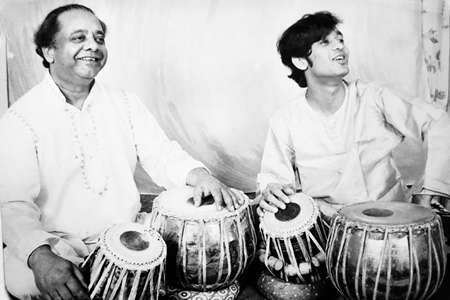
Tabla in his blood . . . Zakir Hussain started performing publicly in his teen years. He is seen here with his legendary father, Ustaad Allarakha Qureshi.
Your concerts seem extremely spontaneous. Yet, they also seem like well-crafted performances that require a lot of rehearsals. What goes into planning these?
Getting to know each other is the most important thing. For instance, Masters of Percussion happens every other year; but that doesn’t mean that I call the musicians two months before the tour and say, can you join me? The year that we are not performing is spent having dinners and going to movies together. We know each other’s families. We do jam sessions as a duo or a trio—everything that helps us connect on many levels. All that is very important for us to tune into each other’s creative process—that’s when the magic happens.
You can bring together a few great musicians into a living room and say, “Okay, now make music.” And they may do a fantastic job. But they would not be able to make the kind of music Shakti does—it’s such a “jump off the cliff without a parachute” kind of music. It’s “take an idea and run with it” kind of music. For that, you need to have musicians who are intimately attuned to each other, knowing fully well what might come next. That is what Shakti is all about.
Do you give any forethought to what you will do with the tabla for any given performance? What tabla language syllables—bols—will you recite? What connections will you make?
Indian music relies on feedback: how the audience is responding, how the hall is humming, how the ambience is, how even the breathing of the audience is. Shakti is a group that’s made for this kind of stuff. It’s always fresh because whatever we played yesterday was yesterday. What will happen today will all be spontaneous. Sure, there are some thoughts in place about going from from point A to point B. But how we will get to those points is left open to cues on the stage. We know each other so well that by just looking into each other’s eyes, we know what’s going to come next. And that’s the magic that that we strive for. Not that it’s always there. But when it’s there, it’s ecstasy of the highest kind!
You mentioned even hearing the breathing of the audience. That is amazing!
You can hear it! Once you have crossed the threshold into a multi-dimensional world, things seamlessly connect with each other. It’s like looking into a flower long enough to finally see it as a giant planet—seeing every little pore of it.
You can only do that with like-minded people, because it’s a collective meditation. When it happens, our mind is focused enough to [fuse into] the vibration of the music, the drone of the music, so much so that you can feel the breathing of the audience; you can feel their reaction even with your eyes closed. It’s a magical place!
Can you tell us a little bit about your upcoming Shakti album?
It is going to be unknown territory even for us. It’s the first time in four decades that we are finally doing a studio album. When we get together in London [to plan the album], we are going to sit there and look at each other, and hope that we can find our way through this whole repertoire that we’ve created, so that we can bring that same energy, the same spontaneity, and somehow incorporate it into a more constructed form of music—to take it even further.
The advantage is that we’ve all grown as musicians. Each one of us has had experiences with different genres of music. Combine that experience with modern day music technology of electronic arrangements, multi tracking etc.—all that is coming together in our album. There are two people in our group who are masters at it: Shankar Mahadevan and V. Selvaganesh. They work in Bollywood and Tollywood respectively and are experts at utilizing electronics and music technology. So, we hope that we can take all these little spices and create a dish-of-the-year for our fans.
All this technology and artificial intelligence that is increasingly being used in music creation—do you see it diminishing human creativity? Or do you feel it can complement and enhance it?
I think it can complement and enhance it—but it has to be used by people who understand both technologies… because using AI in the creative process is not unlike taming a wild horse. You have to know how to ride it, how to make it your own, how to create an understanding between yourself and the wild horse, and then have that horse accept you and your ideas. You need people who have an understanding of both domains, music and technology, like Shankar Mahadevan and V. Selvaganesh, to tame AI in service of creating the best of modern-day music.
Have you been able to preserve the core character of Indian classical music while expanding your repertoire in world music?
Indian classical music is what stimulates my thought process, it gets me going. I don’t have to worry about preserving that part of me as it is deeply ingrained in my DNA since day one. And that “day one” that I’m talking about is from about 5000 years ago. It has flowed through the generations, through so many great legends, and has come to me through my father. So that is something that’s homegrown. And I am perfectly comfortable with it.
What is required for these collaborations is an open mindset and the willingness to recognize that there are no barriers when it comes to creative arts.
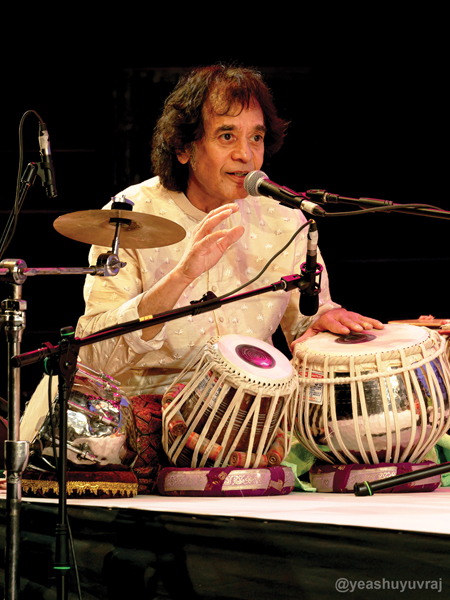
Traditionally, the tabla has played the role mostly of an accompanying instrument. Do you feel that you have succeeded in changing that perception?
I am not solely responsible for this change in perception. The larger-than-life tabla legends like Thirakwa Khansaheb, my father Ustad Allarakha, Pandit Kishan Maharaj, and Pandit Samta Prasad had already done much. These great tabla maestros had amazing performances with the great Pandit Ravi Shankar, Ustad Ali Akbar Khan, and Ustad Vilayat Khan, bringing immense attention to the importance of tabla. Their hard work set the launching pad for myself and my contemporaries.
[Left] Zakir Hussain is more than a global maestro of tabla—he has become a leading icon of Indian classical music on the global stage. (Photo: YeashuYuvraj).
Whether one listens to Beethoven or Mozart, or to a Hindustani or Carnatic composition, all of it can be moving experiences. Yet, there seems to be a distinct subjective difference in what aspects of our being each of these—Western and Indian classical music—tug at. Have you felt the same? Do these genres manage to evoke moods that are different from one to another?
Music has the power to raise your consciousness, whether it is Western or Indian. Doesn’t matter if it’s Vivaldi or Mozart or if it’s Hirabi Barodekar or Ustad Amir Khan. As they say in Hindi about music: “Atma ko parmatma se milaata hai”—it can introduce the mortal to the divine.
You listen to Rimsky-Korsakov’s melody of Scheherazade and you can be transported into a whole different world. So can you when you’re listening to Ustad Amir Khan singing Raga Marwa, or Bala Chandarji doing his 72 melakartas on the veena and telling the story of planet Earth through it, or the great violin maestro M.S. Gopal Krishnan from Karnataka playing a single note, and how it opens up a whole universe of sound for you.
If you are focused and willing enough to let it take you inside, through that rabbit hole, to wherever it wants to take you, you will experience unbelievable ecstasy. It doesn’t matter what kind of music.
I’m curious, do your hands perhaps automatically start tapping onto the utensils or the table surface when eating meals at your home? Are you ever able to switch off the tabla player in you?
Maybe for a few seconds. Lately, it only happens when my granddaughter grabs me. Then the world vanishes. And it’s just her and me, and nothing else exists. That is the kind of feeling and relationship that I feel with her… that I felt and still do with my tabla.
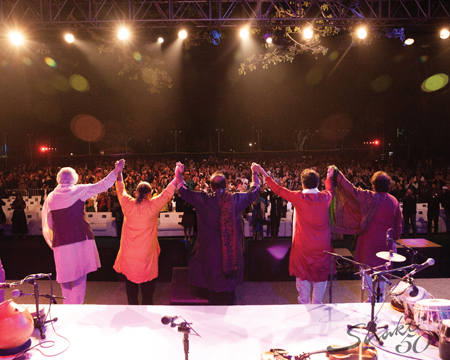
With Shakti, Hussain, along with John McLaughlin, has given the world 50 years of the very best in fusion music.
What kind of music do you find yourself gravitating towards during your leisure time?
I like to listen to folk; it is the music of the Earth, representing the soil, the culture, the mindset, and the people of that place. It also brings me close to my music, because folk music—whether it is Thumri, Kajri, Chaiti, Kirtan, Bhajan—has been responsible for a good bit of Indian classical music. The same in the Carnatic system—there are folk influences there, which we are hesitant to acknowledge, but they exist. Every time you concentrate long enough on classical music, you will hear tonal patterns that hark back to the folk music of that place. Raga Pahadi, for instance, is supposed to be folk music of the mountains.
I have always enjoyed listening to folk music because, whether it’s from Punjab or Bihar or Rajasthan or Kerala or anywhere, it is something that makes me feel like I am in a place which is really very special, this planet, this earth. It has something very special to offer. Folk music of anywhere in the world! Hungarian music, music of New Orleans, blue grass, Senegalese or Mali, Okinawan music, or Bulgarian choirs—it’s all just fantastic.
Classical music is a human deconstructed form of music, from a boon that was given to us by the divine spirits. Folk music, on the other hand, is the music of the divine spirit. Whether it is the incredible rendition of Quranic verses being recited in Kerala while Kanjira players dance in a line, or it’s Lord Krishna playing his bansuri (flute) in Brindavan.
Shuchita Rao is a Hindustani vocalist and educator based in South Florida. She enjoys freelancing on subjects related to Indian art, music, and culture. Find more about her at www.shuchitarao.com
Enjoyed reading Khabar magazine? Subscribe to Khabar and get a full digital copy of this Indian-American community magazine.
blog comments powered by Disqus










